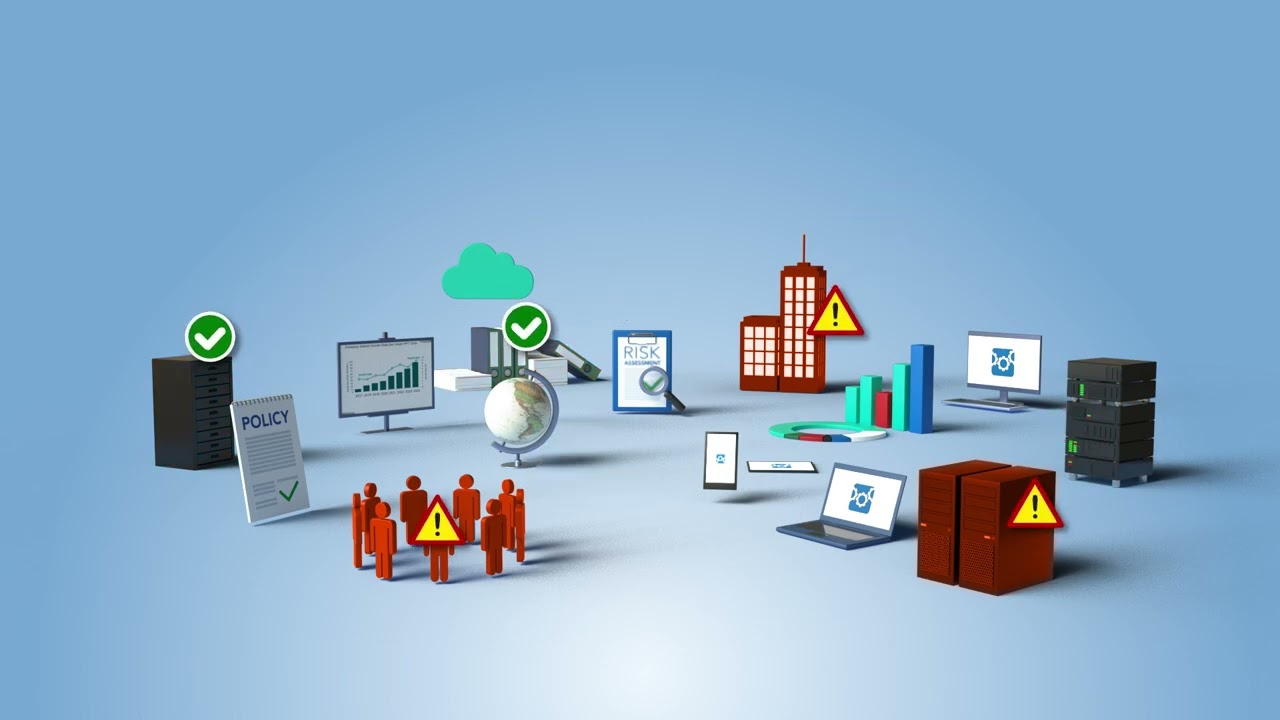Your Roadmap to Risk Reduction!
Table of Contents
ToggleThe Continuum GRC ITAM SaaS platform has hundreds of plugin modules available, such as:

EHS (Environment, Health, and Safety) Checklist & Audit
EHS Compliance is an industry regulation that refers to the rules, policies, programs, and protocols surrounding workplaces and aims to ensure that all company activities do not put the workers' health and safety at risk, or cause any excessive environmental damage. Per the Occupational Safety and Health Administration (OSHA), implementing safety processes also aims to improve compliance with rules, reduce costs, prevent penalties, engage workers, and increase overall business operations.
EHS is enforced by federal and international agencies such as OSHA, the Environmental Protection Agency (EPA), and the Nuclear Regulatory Commission (NRC).
Modules include:
- EHS (Environment, Health, and Safety) Checklist
Overcome Compliance Challenges with Our EHS Solutions
Environmental, Health, and Safety (EHS) compliance standards are designed to help businesses protect both the environment and their employees, while minimizing financial and legal risks. Navigating these standards (and staying on top of any changes) can be complicated, but the EHS solutions from Continuum GRC make it simpler to stay in EHS compliance.
We offer an EHS audit to review your compliance practices and offer smart upgrades for more efficient regulatory compliance measures. We work within your management system to track hazards and incidents, licenses and permits, provide training to staff, and maintain security.
Why Choose Continuum GRC?
Continuum GRC is trusted by the world’s top organizations in navigating and implementing the ever-changing landscape around compliance standards. We have the tools, solutions, and most importantly, the deep expertise that companies need to integrate policies in a way that fits with their management structure and goals.
We deliver comprehensive, customizable, and intuitive solutions to risk management scenarios of all kinds. For years, we’ve helped bring clients up to speed to achieve and maintain regulatory compliance in their industry. Our auditing services are thorough and efficient, pinpointing needed areas for regulatory compliance and smart solutions.
FAQ
What does an EHS compliance audit include?
EHS compliance audits review an organization’s documents, policies, standards and procedures to see how they adhere to state, local, and federal regulations. The process includes interviews with employees and inspection of the physical space. The overall purpose of EHS audits is to spot potential security risks, offer solutions, and promote continuous compliance.
How does an EHS audit checklist improve the audit process?
A checklist offers a systematic, structured, and consistent approach to reviewing the standards and practices for regulatory compliance. It allows the organization to better prepare for official EHS compliance audits. Being able to check these things internally first makes the official procedures smoother and much more efficient.
What are the benefits of using an EHS audit management system?
An EHS audit management system helps track your organization’s EHS programs and practices. It assesses and addresses compliance issues and potential risks around environmental, health, and safety standards, allowing you to be proactive. It also serves as a central data platform where audit findings, inspection results, and corrective actions are all recorded.
How often should EHS audits be conducted?
EHS audits generally conducted on an annual basis to maintain compliance. However, if your organization is part of a high-risk industry (such as construction) or if there are big changes within your company (like new equipment or regulations), more frequent audits may be needed. Semi-annually or quarterly may apply.
What are key components of an EHS compliance audit?
During EHS compliance audits, a few key areas are examined. These include regulatory compliance, including identifying any gaps (and addressing them). Risk assessment looks at hazardous processes and materials. The organization’s documents and record-keeping are reviewed, along with emergency preparedness. The physical workplace is inspected, and employees tested for competency in required EHS training.
How do EHS audits help with regulatory compliance?
When it comes to regulatory compliance, standards and practices around EHS evolve. Being lax or unaware of the most current regulations can put your organization at risk, as well as opening it up to financial penalties, legal exposure, and reputational damage. Auditing services like Continuum GRC make it easy to maintain compliance.
What are you waiting for?
You are just a conversation away from putting the power of Continuum GRC to work for you.
Contact us using the form below or calling us at 1-888-896-6207 for immediate assistance.
To reduce spam submissions, we’ve implemented email verification for access to this form.
How it works:
- Enter your email address below.
- We'll send you a unique verification link.
- Click the link in the email to confirm your identity and gain access to the form.
This ensures only verified users can proceed, helping keep responses genuine and spam-free.
Thank you for your cooperation! If you don't receive the email, check your spam folder or request a new link. If you prefer to speak with a REAL HUMAN, please call our number listed at the top of this page.
About this standard
A compliance overview of an EHS (Environment, Health, and Safety) audit outlines the key components, purpose, and processes involved in ensuring an organization adheres to environmental, health, and safety regulations and standards. Below is a concise yet comprehensive overview:
Purpose of an EHS Checklist & Audit
An EHS checklist and audit are tools used to systematically evaluate an organization’s compliance with applicable EHS regulations, standards, and internal policies. The goal is to:
- Ensure workplace safety for employees.
- Minimize environmental impact.
- Comply with local, national, and international regulations (e.g., OSHA, EPA, ISO 14001, ISO 45001).
- Identify risks, hazards, or non-compliance issues.
- Promote continuous improvement in EHS performance.
Key Components of an EHS Checklist
An EHS checklist is a structured tool used during audits or inspections to assess compliance. It typically includes:
- Environmental Compliance:
- Waste management (hazardous and non-hazardous waste disposal).
- Air emissions and pollution control.
- Water usage and discharge.
- Chemical storage and handling.
- Compliance with environmental permits and reporting requirements (e.g., EPA regulations).
- Health Compliance:
- Occupational health programs such as Continuum GRC.
- Exposure monitoring (e.g., noise, chemicals, radiation).
- Personal protective equipment (PPE) availability and usage.
- Health and hygiene practices (e.g., sanitation, ventilation).
- Safety Compliance:
- Workplace hazard identification and control (e.g., fire, electrical, fall risks).
- Emergency preparedness (e.g., fire drills, evacuation plans, first aid).
- Machine guarding and equipment safety.
- Employee training on safety protocols.
- Incident reporting and investigation procedures.
EHS Audit Process
An EHS audit involves a systematic review to verify compliance and identify gaps. The process typically includes:
- Planning:
- Define the scope (e.g., specific facilities, processes, or regulations).
- Identify applicable regulations (e.g., OSHA 1910, EPA Clean Air Act, or local laws).
- Assemble an audit team with relevant expertise.
- Checklist Development:
- Customize the checklist to reflect site-specific operations and regulatory requirements.
- Include measurable criteria (e.g., “Are fire extinguishers inspected monthly?”).
- Execution:
- Conduct on-site inspections, interviews, and document reviews.
- Use the checklist to evaluate compliance and record observations.
- Collect evidence (e.g., photos, records, employee feedback).
- Reporting:
- Document findings, including compliant areas and non-conformities.
- Categorize issues by severity (e.g., critical, major, minor).
- Recommend corrective actions and timelines.
- Follow-Up:
- Verify implementation of corrective actions.
- Monitor ongoing compliance through periodic audits or inspections.
Key Regulations and Standards
An EHS checklist and audit typically align with:
- OSHA (Occupational Safety and Health Administration): U.S. workplace safety standards (e.g., 29 CFR 1910).
- EPA (Environmental Protection Agency): U.S. environmental regulations (e.g., Clean Water Act, Resource Conservation and Recovery Act).
- ISO 14001: International standard for environmental management systems.
- ISO 45001: International standard for occupational health and safety.
- Local Regulations: State or country-specific laws (e.g., EU REACH for chemical management).
Benefits of EHS Checklist & Audit
- Reduces workplace accidents and injuries.
- Ensures regulatory compliance, avoiding fines or legal penalties.
- Minimizes environmental harm and enhances sustainability.
- Improves employee morale and organizational reputation.
- Identifies cost-saving opportunities (e.g., energy efficiency, waste reduction).
Best Practices
- Regular Audits: Conduct audits annually or as required by regulations.
- Employee Involvement: Engage workers in the process to foster a safety culture.
- Technology Use: Leverage EHS software for tracking, reporting, and data analysis.
- Continuous Improvement: Use audit findings to update policies and training.
Amazing Benefits

